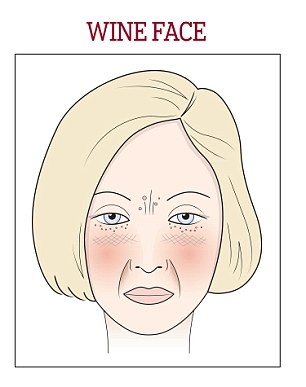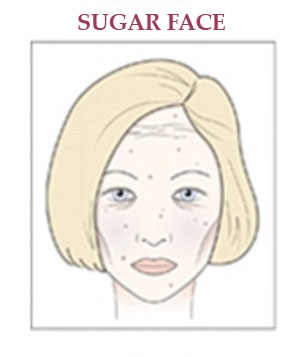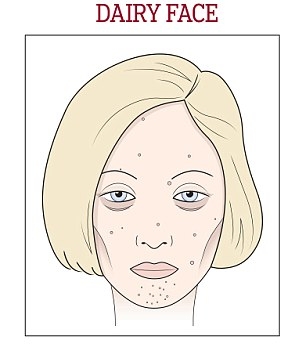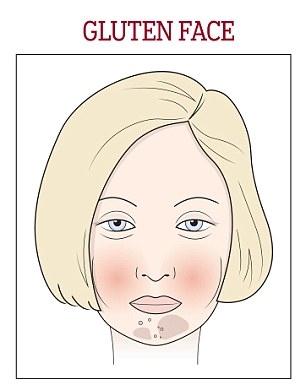It is impossible to underestimate the influence of food on the face – it reveals the whole truth about health. Even in ancient times, it was known about facial maps, which show the relationship of certain zones with the internal organs of a person. Any food intolerance problems you may not even know you have, and/or overconsumption of certain substances can trigger a cascade of chemical and hormonal changes that accelerate the aging process inside and out of our body. The four food groups that affect facial skin the most are alcohol, sugar, gluten, and dairy.
The influence of food on the aging process of the face
Wine Face

Typical features:
- marked wrinkles or redness between the eyes;
- drooping of the upper eyelids;
- enlarged pores;
- dry skin;
- small lines on the cheeks;
- Redness of the cheeks and nose;
- deep nasolabial folds.
Reason:
- Alcohol robs the skin of moisture, causing wrinkles and lines on the face to become deeper and more pronounced.
- The high content of sugar in alcoholic beverages, which breaks down the collagen necessary for skin elasticity. As a result, alcohol "poured out" into enlarged pores and drooping of the upper eyelids.
- Suppression of enzymes that fight inflammation can lead to reddening of the cheeks and nose.
The area between the eyes is connected to the liver, so redness or wrinkles appear there. Also a sign of a weakened liver is a purple tint to the tongue.
Sugarface

Effects of foods containing sugar on the skin of the face:
- lines and wrinkles on the forehead;
- saggy skin under the eyes;
- thin face;
- painful pustular-like spots all over the face;
- skin thinning;
- greyish or whitish skin tone.
Reason:
- Glication – the interaction of glucose molecules with collagen, as a result of which collagen fibers lose their flexibility and elasticity, and the skin becomes thin and flabby, especially under the eyes.
- Excessive sugar affects the distribution of fat, resulting in a thin face.
- Sugar has a negative effect on the digestive system, leading to acne on the face, shoulders and chest.
- Paleness of the skin is due to an increase in the hormone insulin, which stimulates the production of the stress hormone cortisol. Cortisol leads to vasoconstriction in the face and malnutrition of the skin.
- The hair on the eyebrows also becomes thinner as a result of excessive insulin production, which overloads the adrenal glands.
The forehead area, according to the face map, represents the digestive process, which is negatively affected by sugar. That is why wrinkles in this case appear on the forehead.
Milky Face

Typical signs of the effect of dairy products on the skin of the face:
- swollen eyelids;
- bags and dark circles under the eyes;
- small white dots on the spots on the chin.
Reason:
- Loss of enzymes that help digest lactose efficiently.
- The immune system produces anti-inflammatory chemicals that also act on the skin.
- A glass of milk can contain about 20 different hormones and chemicals, some of which upset the balance of your hormones, namely estrogen and progesterone. As a result, the pores become clogged with actively growing skin cells and bacteria.
It is the chin that is associated with the human reproductive organs, so skin problems most often appear in this part of the face.
Gluten Face

Typical signs of the influence of foods containing gluten:
- chubby red cheeks;
- dark pigment spots in the chin area.
Reason:
- Increased inflammatory response, causing the face to look inflamed or swollen.
- Affects the cells responsible for skin pigmentation, resulting in age spots on the chin.
- The reaction of the immune system disrupts the hormonal balance, which is also expressed in age spots on the chin.
- Gluten can cause rosacea.
To neutralize such a harmful effect of food on the skin of the face, it is necessary to give the body a break from the products that negatively affect it – limit their use as much as possible or temporarily refuse alcohol, gluten, sugar or dairy products. It is also recommended to go to a doctor who will help identify problems invisible to the naked eye and prescribe the appropriate treatment.






Add a comment